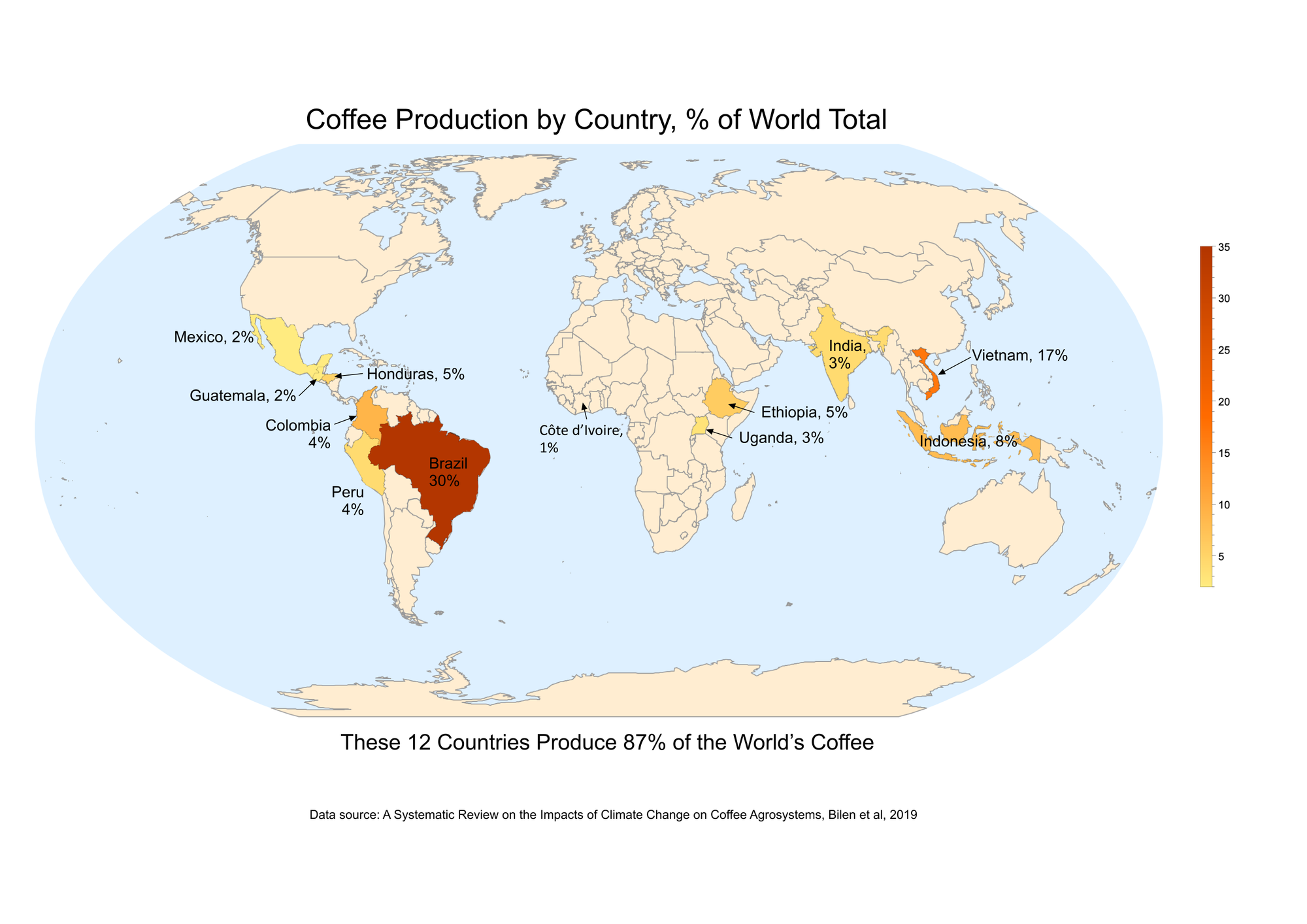Coffee - Climate Change Gets Personal
Coffee – many of us can’t live without our daily fix, but what is the environmental footprint of our daily cup(s), and what impact does a warming planet have on the future of coffee production?

Sometime around 2,200 years ago, give or take 700 years, in the highlands of what is now the Keffe region of southwestern Ethiopia, a goatherd named Kaldi noticed his herd of goats capering and prancing about with great energy, while they were chewing on a type of red cherry he had never before noticed. He tried some of the cherries himself, and soon joined his goats in their capers. Thus was discovered Rubiaceae coffea arabica, the plant whose seeds we know as coffee beans.
At least that is the legend told in Ethiopia. The legend is impossible to verify, but coffee in various forms has been a key part of Ethiopian culture for a very long time. The beans first came to the attention of the outside world in the 15th century by way of the Yemenis, who were looking for an alternative to tea, to which they had been introduced by the Chinese. The dispersion of coffee plants to the rest of the world is a tale of intrigue in circumventing the Ottoman Empire’s imperial monopoly on coffee, and both followed and influenced the expansion of world commerce and trade routes.1
Coffee had a role in inadvertently establishing a major industry - marine insurance. In London following the great fire of 1666, businessmen met in coffee houses that escaped the conflagration. Edward Lloyd’s coffee house near the Thames river was the favourite gathering place of ship owners, who clubbed together to reduce their risks, giving rise to marine insurance.2
We at Sweet Lightning view coffee as being mission-critical to our work. We confess to being coffee snobs, turning up our noses at mass market Robusta grounds, opting instead for various Arabica varietals from our local roaster, convinced that our particular method of home brewing yields the best cup. We once vacationed at a B&B located on a coffee plantation in Hawaii. We are not addicted - we can stop any time - we just choose not to!
Coffee plants don’t grow where we in Sweet Lightning live. The beans have to be imported over great distances from places where it does grow. That raises at least two important questions;
- What is the environmental footprint of our daily cup(s)?
- What impact does a warming planet have on the future of coffee production?
There are about 130 species of coffee plants in the coffea genus,3 but two species accounted for most of the world’s coffee, Arabica (coffea arabica) at about a third of global production, and Robusta (coffea canephora) at about two thirds of the total at the end of 2024.4 While over 70 countries grow coffee, 87% of the world’s total production comes from a dozen countries, although production varies from year to year and from country to country.
Brazil, Vietnam and Columbia are the top three producers and exporters, accounting for more than half of all exports. All coffee-growing countries are located between the tropics of Cancer and Capricorn. Roughly 90% of all coffee is exported as green beans to be roasted elsewhere.

These coffee producing countries only consume about 30% of the world total, while the USA, Europe, and Japan, combined, consume about half of world production.5
Many varied steps are required to produce the coffee in your cup, and determining the environmental footprint of those steps is complex. While there are non-greenhouse gas (GHG) impacts from the coffee industry, most Life Cycle Analysis (LCA) studies that have been done confine themselves to measuring GHG emissions of the approximately thirteen steps required. Those steps begin with cultivation and irrigation, and end with dish-washing and end-of-life processes for grounds and packaging.6
Making equivalent comparisons in findings between different LCA literature review studies is difficult, in part because methodologies and units used differ. For example, one study7 gives the carbon dioxide equivalent (CO2e) per brewed serving of coffee but does not define serving size, while another8, which does give CO2e per serving, states that post-brewing size is 280 mL (about 9 1/2 oz).
The GHGs generated are both highly variable and counter-intuitive, at least to us. We expected that transporting the beans from the tropics to higher latitudes would make up the bulk of the GHG footprint, but transportation is, in almost all cases, one of the smallest contributors. We also expected that there would be a significant difference between organic and/or shade-grown coffee, and coffee grown in full sun, which needs more inputs like fertilizer, irrigation and pesticides, but there are offsetting trade-offs so that it is not clear which is better from a GHG perspective.9
The non-GHG benefits of shade-grown coffee, compared to sun-grown, include retention of habitat for species diversity, soil conservation, less pesticide use, and improved pollination.10
The two biggest interdependent contributors to coffee GHGs are the amount of dry coffee used11 (40 - 80%)12, and the final brewing of the coffee. The method used to brew the coffee is the biggest determinant of the GHG footprint, in a couple of ways.
The first way is that different brewing methods use varying amounts of beans to achieve the same ends. In order of bean usage, from most to least, the methods are; traditional drip filter, coffee capsules, French press, instant coffee, and espresso. Not all studies agree on this order, with some swapping round the last two, and of course there are other methods not covered by all studies. The worst GHG footprint of all coffee types is a latte, which, because of the milk in it, inherits the GHG footprint of the dairy industry, although the coffee content is no higher.
The second way is that brewing methods vary widely in how much water they use. The GHG intensity of the energy source used to boil that water, whether electricity or fossil fuels, is part of the footprint of the final cup.
There is another variable related to methods used, which can affect coffee’s GHG footprint, namely, how much excess coffee is made and not consumed. How frequently do we make a pot of filter coffee, leave it in the coffee maker with the heater on, and in the end don’t drink it all? Methods like capsule, instant or espresso tend to more closely match both the amount of coffee and water used, and result in less waste of both.
How will coffee production be affected by climate change in the future?
As one review study13 put it, “coffee production is fragile”. Coffee plants require relatively stable temperature and humidity conditions. In particular, when a specific technical measure of atmospheric relative humidity called “vapour pressure deficit” gets too high (i.e. the air is too dry for the temperature), coffee plants don’t grow well, produce fewer beans, and the quality of the beans suffers.14
While no one can predict exactly how quickly the climate will warm and by how much, it is clear that the world’s climate will get hotter, drier and more variable.15 When the vapour pressure deficit is above a certain threshold, coffee plant yields decline dramatically, and that threshold will be crossed for most coffee-growing countries when global warming is greater than 2 °C16. The areas that are currently suitable for growing coffee will shrink and those that remain won’t produce as much coffee, while the loss of suitable arabica growing zones may be somewhat offset by those zones becoming suitable for robusta coffee.17
Mitigation strategies for growers appear limited. Growing coffee under shade helps reduce temperature and so extends the areas that can support coffee. Irrigation and other water management strategies help to offset the increased leaf transpiration that results from increased vapour pressure deficit. Breeding new varieties of coffee plants that are more resistant to heat and dryness may also be needed.18
The future prospects for coffee look grim, but there may be some hope among the other 130-ish species of coffee plants that do not currently dominate the world's production. One example is a species of coffee, named excelsa, native to South Sudan, Congo, Central African Republic, and Congo, that was discovered a century ago. The plant’s natural form is a big tree with deep roots and thick, leathery leaves, all of which make it better adapted to heat and drought. As a bonus, the beans produce better-tasting coffee than common robusta varieties.19
The wonderful diversity of the earth’s ecosystem may just possibly bail us out of this self-inflicted predicament.
Reading
1. Halevy, Alon. The Infinite Emotions of Coffee. Macchiatone Communications, 2011.
2. “Coffee and Commerce 1652-1811.” Accessed April 9, 2025. https://www.lloyds.com/about-lloyds/history/coffee-and-commerce.
3. Bilen, Christine, Daniel El Chami, Valentina Mereu, Antonio Trabucco, Serena Marras, and Donatella Spano. “A Systematic Review on the Impacts of Climate Change on Coffee Agrosystems.” Plants 12, no. 1 (December 25, 2022): 102. https://doi.org/10.3390/plants12010102.
4. Monthly Coffee Market Report, January 2025, International Coffee Organization, Accessed April 13, 2025. https://www.ico.org/documents/cy2024-25/cmr-0125-e.pdf.
5. Heller, Martin. “Food Product Environmental Footprint Literature Summary: Coffee”, State of Oregon Department of Environmental Quality, September 2017, Accessed March 28, 2025. https://www.oregon.gov/deq/filterdocs/pef-coffee-fullreport.pdf.
6. Heller, Martin, op. cit.
7. Heller, Martin. “Food Product Environmental Footprint Literature Summary: Coffee”, State of Oregon Department of Environmental Quality, September 2017, Accessed March 28, 2025. https://www.oregon.gov/deq/filterdocs/pef-coffee-fullreport.pdf.
8. Marty, Charles, Jean-François Boucher, Luciano Rodrigues Viana, and Pierre-Luc Dessureault. “Here’s How Your Cup of Coffee Contributes to Climate Change.” The Conversation, January 5, 2023. http://theconversation.com/heres-how-your-cup-of-coffee-contributes-to-climate-change-196648.
9. Heller, Martin, op. Cit.
10. Smithsonian’s National Zoo and Conservation Biology Institute. “Ecological Benefits of Shade-Grown Coffee.” Accessed April 20, 2025. https://nationalzoo.si.edu/migratory-birds/ecological-benefits-shade-grown-coffee.
11. Hicks, Andrea L. “Environmental Implications of Consumer Convenience: Coffee as a Case Study.” Journal of Industrial Ecology 22, no. 1 (2018): 79–91. https://doi.org/10.1111/jiec.12487.
12. Marty, Charles, et al, op. Cit.
13. Bilen, Christine, et al, op. cit.
14. teamneubiom. “The Impact of Rising Vapour Pressure Deficit (VPD) on Coffee Production: A Climate Change Challenge.” NeuBiom Labs, December 11, 2024. https://www.neubiom.com/post/the-impact-of-rising-vapour-pressure-deficit-vpd-on-coffee-production-a-climate-change-challenge.
15. “The Earth Is Getting Drier – State of the Planet,” March 18, 2025. https://news.climate.columbia.edu/2025/03/18/desertification-the-earth-is-getting-drier/.
16. teamneubiom. “The Impact of Rising Vapour Pressure Deficit (VPD) on Coffee Production: A Climate Change Challenge.” NeuBiom Labs, December 11, 2024. https://www.neubiom.com/post/the-impact-of-rising-vapour-pressure-deficit-vpd-on-coffee-production-a-climate-change-challenge.
17. Bilen, Christine, et al, op. cit.
18. teamneubiom. “The Impact of Rising Vapour Pressure Deficit (VPD) on Coffee Production: A Climate Change Challenge.” , op. cit.
19. Press, Associated. “Could This Rare Bean Be the Solution to the Global Coffee Crisis?” Fast Company, March 3, 2025. https://www.fastcompany.com/91288810/could-this-rare-bean-solution-global-coffee-crisis.